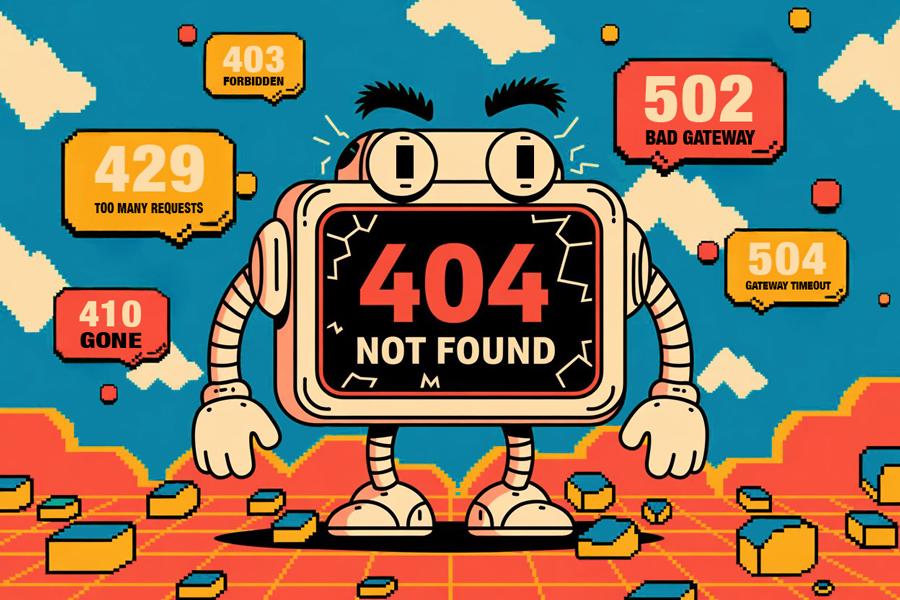In this article, we will explain the most common HTTP error codes you may encounter at Seravo or other hosting services, what they mean and what you can do about them.
When you browse websites, you will surely come across these status or error codes. They are part of the communication between browsers and servers, and tell you how the server has processed the request we made – and what happens next.
HTTP error codes are part of HTTP status codes. Not all status codes are errors: for example, HTTP 200 means that everything is OK.
Status codes are divided into five different series based on their first number.
HTTP Status Codes
5xx Server Error: The request was not successfully completed due to an error caused by the server
1xx Informal: The request has been received, continuing
2xx Successful: The request has been received, understood and processed
3xx Redirection: Further actions are required to complete the request
4xx Client Error: The request was not successfully completed due to an error caused by the client
Error on the Server?
An error can occur if the server is experiencing a problem that’s hindering the execution of the site’s PHP code. If the problem occurs on Seravo’s end, it will be reported in real time on the Seravo Status page. You can also subscribe to error notifications!
If there are no problems reported on the aforementioned status page, the error most likely happens on your site only. Continue reading to find out what status codes you may encounter and what they can reveal to you, developer!
The Most Common HTTP Error Codes with Seravo – What to Do?
403 Forbidden
Access is denied, for example, listing directories is blocked by default in Seravo for security reasons. It could also be a customized block for a specific page.
404 Not Found
If it is a single page, make sure the URL is correct (for example in a link). If the URL has changed, a 301 redirect should be made. You can manage redirects with a plugin, for example with Redirection. If the entire site is giving out a 404 response, it can signify a more crucial problem on your site. Our customer service is happy to help you to troubleshoot such issues.
410 Gone
The site has been terminated, its billing period has ended, and the site is closed. Contact customer service if you suspect an error here.
429 Too Many Requests
You may encounter the 429 status code when using a tool that crawls and loads all pages of the site too quickly. If this happens, it is worth checking the tool’s settings, so that it scans the site more slowly.
Part of Seravo’s maintenance is that we take care of many things for our customers, so that you do not have to worry about them alone. As a part of our protection towards any malicious activity towards your site, a block may be activated if the same IP address is browsing your page too quickly. This is to prevent denial of service attacks from happening, or brute force attacks towards the WordPress login page.
Learn more about the 429 HTTP status at Seravo and what you can do about it.
500 Internal Server Error
Despite its perhaps slightly misleading name, the reason for the HTTP 500 response usually originates within the site’s code. One instance in which it occurs is when a plugin has been updated, but something has gone wrong. More detailed information can be found in the error log (php-error.log).
502 Bad Gateway
The server did not receive the expected, functional response from another server to which it had tried to direct traffic to. Fixing the HTTP 502 error requires more detailed troubleshooting. The error can relate to server and network connections, as well as possible server or application errors.
503 Service Unavailable
The site is in maintenance mode, for which the customer usually uses an add-on. HTTP 503 Service Unavailable is an SEO-friendly response from the server and search engines will return to index the page later, when the site is available again.
504 Gateway Timeout
If you try to open a WordPress page with a browser but it takes a long time to load and nothing happens for several minutes, you may encounter the HTTP 504 error code. It is possible that the PHP of your site is still being executed in the background, but because the request could not be completed, your browser has stopped waiting for results.
The root cause of the 504 response can be an implementation or design error in the PHP code, where the PHP code is trying to load too much data from the database, or making an external API request to another server that is not responding in a timely manner.
The issue should be fixed by making the code execute faster or in smaller parts, and by making the PHP code provide interim information about its progress instead of doing nothing at all. There may also be an error in the PHP code that stops its execution completely, without any error message.
Seravo can help developers examine the PHP code as an additional service, but if you have the skills, it is good to remember that as our customer you have access to Seravo’s developer tools. Use these tools to examine PHP error logs extensively and analyze the speed of the PHP code and what it does. For more information, see the developer documentation.

Our Tips for Developers about HTTP Status Codes
- Track 404 errors with the Redirection plugin
The Redirection plugin, which is handy for creating redirects, can also track 404 error codes on your site. In the plugin’s settings, you can turn on a feature that saves log information about 404 errors. This helps you to observe and fix broken links or create redirects. - Read the log files with Seravo Plugin
Seravo customers always have access to their site’s log files, which contain extensive information about the site’s operation. The logs can be found in the Seravo Plugin’s settings under Tools > Logs and on the server in the path/data/log. The logs help you find out what is happening on the site and find possible causes of the problem. - Data locations and log files
Our developer documentation contains all the default file paths, paths to log files and htdocs files for Seravo sites. Check them out here!
